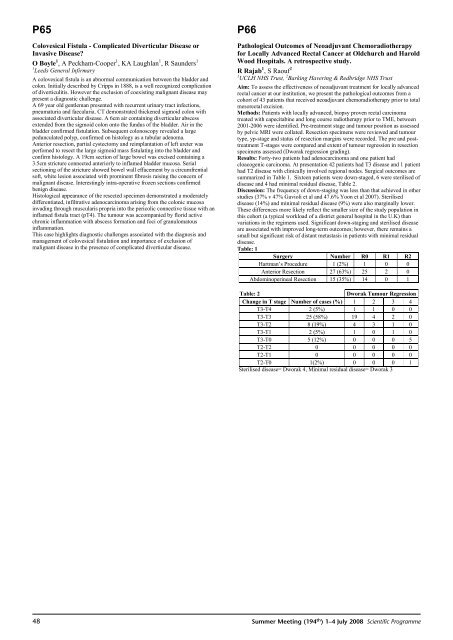2008 Summer Meeting - Leeds - The Pathological Society of Great ...
2008 Summer Meeting - Leeds - The Pathological Society of Great ...
2008 Summer Meeting - Leeds - The Pathological Society of Great ...
You also want an ePaper? Increase the reach of your titles
YUMPU automatically turns print PDFs into web optimized ePapers that Google loves.
P65Colovesical Fistula - Complicated Diverticular Disease orInvasive Disease?OBoyle 1 , A Peckham-Cooper 1 , KA Laughlan 1 , R Saunders 11 <strong>Leeds</strong> General InfirmaryA colovesical fistula is an abnormal communication between the bladder andcolon. Initially described by Cripps in 1888, is a well recognized complication<strong>of</strong> diverticulitis. However the exclusion <strong>of</strong> coexisting malignant disease maypresent a diagnostic challenge.A 69 year old gentleman presented with recurrent urinary tract infections,pneumaturia and faecaluria. CT demonstrated thickened sigmoid colon withassociated diverticular disease. A 6cm air containing diverticular abscessextended from the sigmoid colon onto the fundus <strong>of</strong> the bladder. Air in thebladder confirmed fistulation. Subsequent colonoscopy revealed a largepedunculated polyp, confirmed on histology as a tubular adenoma.Anterior resection, partial cystectomy and reimplantation <strong>of</strong> left ureter wasperfomed to resect the large sigmoid mass fistulating into the bladder andconfirm histology. A 19cm section <strong>of</strong> large bowel was excised containing a3.5cm stricture connected anteriorly to inflamed bladder mucosa. Serialsectioning <strong>of</strong> the stricture showed bowel wall effacement by a circumfrentials<strong>of</strong>t, white lesion associated with prominent fibrosis raising the concern <strong>of</strong>malignant disease. Interestingly intra-operative frozen sections confirmedbenign disease.Histological appearance <strong>of</strong> the resected specimen demonstrated a moderatelydifferentiated, infiltrative adenocarcinoma arising from the colonic mucosainvading through muscularis propria into the pericolic connective tissue with aninflamed fistula tract (pT4). <strong>The</strong> tumour was accompanied by florid activechronic inflammation with abscess formation and foci <strong>of</strong> granulomatousinflammation.This case highlights diagnostic challenges associated with the diagnosis andmanagement <strong>of</strong> colovesical fistulation and importance <strong>of</strong> exclusion <strong>of</strong>malignant disease in the presence <strong>of</strong> complicated diverticular disease.P66<strong>Pathological</strong> Outcomes <strong>of</strong> Neoadjuvant Chemoradiotherapyfor Locally Advanced Rectal Cancer at Oldchurch and HaroldWood Hospitals. A retrospective study.RRajab 1 ,SRaouf 21 UCLH NHS Trust, 2 Barking Havering & Redbridge NHS TrustAim: To assess the effectiveness <strong>of</strong> neoadjuvant treatment for locally advancedrectal cancer at our institution, we present the pathological outcomes from acohort <strong>of</strong> 43 patients that received neoadjuvant chemoradiotherapy prior to totalmesorectal excision.Methods: Patients with locally advanced, biopsy proven rectal carcinomatreated with capecitabine and long course radiotherapy prior to TME, between2001-2006 were identified. Pre-treatment stage and tumour position as assessedby pelvic MRI were collated. Resection specimens were reviewed and tumourtype, yp-stage and status <strong>of</strong> resection margins were recorded. <strong>The</strong> pre and posttreatmentT-stages were compared and extent <strong>of</strong> tumour regression in resectionspecimens assessed (Dworak regression grading).Results: Forty-two patients had adenocarcinoma and one patient hadcloacogenic carcinoma. At presentation 42 patients had T3 disease and 1 patienthad T2 disease with clinically involved regional nodes. Surgical outcomes aresummarized in Table 1. Sixteen patients were down-staged, 6 were sterilised <strong>of</strong>disease and 4 had minimal residual disease, Table 2.Discussion: <strong>The</strong> frequency <strong>of</strong> down-staging was less than that achieved in otherstudies (37% v 47% Gavioli et al and 47.6% Yoon et al 2007). Steriliseddisease (14%) and minimal residual disease (9%) were also marginally lower.<strong>The</strong>se differences more likely reflect the smaller size <strong>of</strong> the study population inthis cohort (a typical workload <strong>of</strong> a district general hospital in the U.K) thanvariations in the regimens used. Significant down-staging and sterilised diseaseare associated with improved long-term outcomes; however, there remains asmall but significant risk <strong>of</strong> distant metastasis in patients with minimal residualdisease.Table: 1Surgery Number R0 R1 R2Hartman’s Procedure 1 (2%) 1 0 0Anterior Resection 27 (63%) 25 2 0Abdominoperineal Resection 15 (35%) 14 0 1Table: 2Dworak Tumour RegressionChange in T stage Number <strong>of</strong> cases (%) 1 2 3 4T3-T4 2 (5%) 1 1 0 0T3-T3 25 (58%) 19 4 2 0T3-T2 8 (19%) 4 3 1 0T3-T1 2 (5%) 1 0 1 0T3-T0 5 (12%) 0 0 0 5T2-T2 0 0 0 0 0T2-T1 0 0 0 0 0T2-T0 1(2%) 0 0 0 1Sterilised disease= Dworak 4, Minimal residual disease= Dworak 348 <strong>Summer</strong> <strong>Meeting</strong> (194 th ) 1–4 July <strong>2008</strong> Scientific Programme













